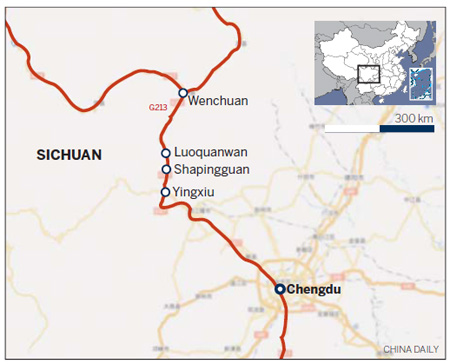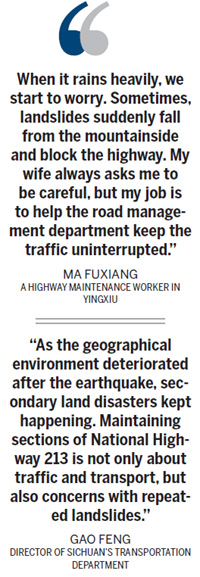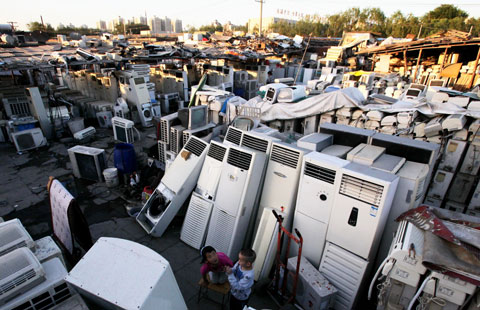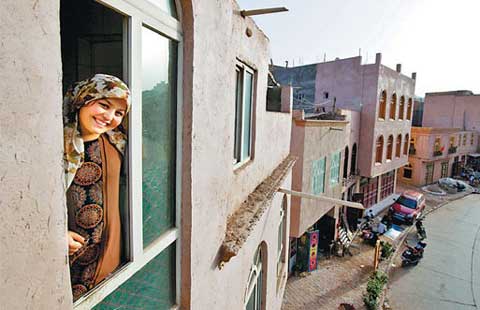Battle to keep key route open
By Hu Yongqi (China Daily) Updated: 2011-07-19 07:22Just in time

Wang Jiaming, 38, was in neighboring Dujiangyan on business July 6 when he got the message from his wife in Wenchuan: She had gone into labor. He knew that Highway 213 was the best route home, a two-hour drive. He didn't know the road was closed.
When he had to stop his truck, paramilitary forces told him he could take a boat across the new lake about 1 km away. Wang climbed over rocks and found his feet stuck in mud three times, but he kept going and reached the riverbank in 30 minutes. He found 20 villagers there, also waiting for a ride.
Wang said his mother had died in the earthquake never having seen a grandchild, and that nothing would keep him from seeing his child born. Then he could tell his mother about the new life that had come to the family.
About 30 minutes later, the boat arrived, and Wang broke into a smile. Once on the other side, he began walking with other Wenchuan natives. He covered the 30 km in time to witness the birth of his son.
High, steep, unstable
A makeshift road for passengers and cars opened on Friday, but trucker Luo's load is too heavy. Zhu, the county official, said Highway 213 is expected to be fully repaired and open on Thursday.

It has taken more than 700 workers and 300 machines to reach this point in the repairs.
The highway was severely damaged by the 2008 quake but was rebuilt. The route is still at the foot of Longmen Mountain, along the bank of the Minjiang, in the core of the earthquake zone.
The narrow watercourse is vulnerable to heavy rains that threaten the road base, said Feng Xuegang, general manager of Dujiangyan-Wenchuan Highway Co.
"The mountains along the highway are very high, mostly with a steep slope. This increases the possibility of landslides," said Huang Jinping, general manager of Sichuan Road & Bridge. He has been in charge of the operation in Wenchuan since July 3.
His company rebuilt the highway after the earthquake, and now it functions as the rapid reaction force to protect it. Huang said his employees have repaired about 100 sections of the highway since 2008.
When the rain continues after a slide, he said, it makes the repair work that much more difficult. "The rainy season usually begins in late July and lasts until September, but this year it is 15 days earlier and challenges us with more tasks to repair the highway."
Wang Xiang, an engineer with Sichuan Road, was instructing 20 workers on reinforcing the road base. They used a steel net and seven concrete piers, but still the floodwaters, running at 1,200 cubic centimeters a second, washed them away.
The mud and rocks provide unstable foundations for the heavy equipment, Huang said. A digging machine was trapped as it worked in the middle of the river, but the operator managed to escape. Four days later, it was pulled out the mud by another, larger digger.
Prevention methods
"As the geographical environment deteriorated after the earthquake, secondary land disasters kept happening. Maintaining sections of National Highway 213 is not only about traffic and transport, but also concerns with repeated landslides," said Gao Feng, director of Sichuan's transportation department. "Therefore, the maintenance of the highway also includes flood control and soil conservation."
After the earthquake, Sichuan's land and resources department examined 28,395 sites across the province for potential geographic disasters. More than 11,300 sites were in the quake-hit areas. Last year, work was completed to avert 181 potential disasters that might have affected 39,000 people, the department said.
A simple process is used on some hillsides: Foliage has been planted to hold the soil in place, and steel netting holds the plants to the slopes, at least until they are well established.
Xu Zhiwen, the department's deputy director, described a more elaborate approach - using heavier steel nets to contain debris that already has fallen so it doesn't travel farther or block a river. Rainwater can flow around the boulders and other debris and proceed down its normal, if swollen, course.
Last August, a landslide sent 800,000 cubic meters of rocks and soil down Hongchun Ravine, about half of it into the Minjiang River, damming it. Highway 213 was closed for about a week.
The technique that Xu described was launched in December, and Chengdu-based Huadi Co built 19 debris-controlling dams over six months. On July 3, Hongchun Ravine was able to withstand the deluge.
Xu said it costs 100-200 million yuan to restore one damaged ravine by containing its debris. Local authorities said they are short of money for flood control and soil conservation, but they know that those are the fundamental ways to keep traffic moving on National Highway 213.
Huang Zhiling and Li Yu contributed to this report.
- Seven villagers murdered in N China
- China steps up tobacco control efforts
- Five jailed for separatism in Xinjiang
- Letter asks for leniency in poisoning case
- Antibiotics in surface water pose 'indirect health risk'
- Tianjin airport opens up transit link to Beijing
- High levels of antibiotics in China's major rivers
- China to dig tunnel for Asian rail system
- Bering strait line to US possible, experts say
- China: Stop oil rig harassment







